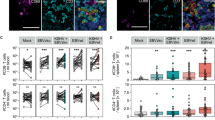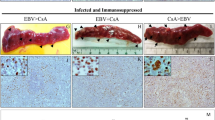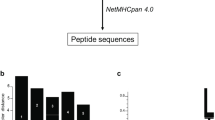Abstract
EPSTEIN-BARR VIRUS (EBV) is the causative agent of most infectious mononucleosis1 and is also associated with two human tumours, Burkitt's lymphoma (BL)2 and nasopharyngeal carcinoma2. Lymphoid cell lines of B-cell origin have been established from patients with these diseases, and from lymphocytes transformed in vitro by EBV3. In lymphoid cell lines the lytic viral cycle is usually repressed even though the cells carry multiple copies of the EBV genome. These cells therefore provide a valuable model for the study of latent EBV infection. Although EBV is ubiquitous, its association with human malignant disease is to a large extent both ethnically and geographically restricted2 and it is therefore of interest to understand the host factors involved in the regulation of the expression of the latent EBV genome. In infectious mononucleosis, EBV infection is associated not only with a specific anti-EBV antibody2 and T-lymphocyte response4 but also with an increase in nonspecific IgM production5. EBV-infected B lymphocytes produce polyclonal Ig (ref. 6) and the majority of established EBV genome-positive lymphoid cell lines possess surface IgM (ref. 7). We report here that treatment of several human lymphoid cell lines with antisera to human IgM activates the latent EBV genome to give a marked increase in EBV-specific early antigen (EA). Also, in some cell lines this treatment induces an increase in virus capsid antigen (VCA).
This is a preview of subscription content, access via your institution
Access options
Subscribe to this journal
Receive 51 print issues and online access
$199.00 per year
only $3.90 per issue
Buy this article
- Purchase on SpringerLink
- Instant access to full article PDF
Prices may be subject to local taxes which are calculated during checkout
Similar content being viewed by others
References
Henle, W. & Henle, G. in Oncogenesis and Herpes Viruses (eds Briggs, P. M., De-Thé, G. & Payne, L. M.) 269–274 (Int. Agency Res. Cancer, Lyon, 1972).
De-Thé, G. & Lenoir, G. in Comparative Diagnosis of Viral Diseases (eds. Kurstak, E. & Kurstak, C.) 195–240 (Academic, New York, 1977).
Henle, W., Diehl, V., Kohn, G., zur Hausen, H. & Henle, G. Science 157, 1064–1065 (1967).
Svedmyr, E. & Jondal, M. Proc. natn. Acad. Sci. U.S.A. 72, 1622–1626 (1975).
Wollheim, F. A. & Williams, R. C. New Engl. J. Med. 274, 61–67 (1966).
Rosen, A., Gergely, P., Jondal, M., Klein, G. & Britton, S. Nature 267, 52–54 (1977).
Fialkow, P. J., Klein, E., Klein, G., Clifford, P. & Singh, S. J. exp. Med. 138, 87–102 (1973).
Lenoir, G., Berthelon, M.-C., Favre, M. C. & De-Thé, G. Biomedicine 23, 461–464 (1975).
Hampar, B., Derge, J. G., Matros, L. M. & Walker, J. L. Proc. natn. Acad. Sci. U.S.A. 69, 78–82 (1972).
Gerber, P. Proc. natn. Acad. Sci. U.S.A. 69, 83–85 (1972).
Hampar, B., Lenoir, G., Nonoyama, M., Derge, J. G. & Chang, S. Y. Virology 69, 660–668 (1976).
Zur Hausen, H., O'Neill, F. J., Freese, U. K. & Hecker, E. Nature 272, 373–375 (1978).
Nadkarni, J. S. et al. Cancer, 23, 64–79 (1969).
Epstein, A. L., Henle, W., Henle, G., Hewetson, J. F. & Kaplan, H. S. Proc. natn. Acad. Sci. U.S.A. 73, 228–232 (1976).
Theofilopoulos, A. N., Bokisch, V. A. & Dixon, F. J. J. exp. Med. 139, 696–711 (1974).
Klein, G. et al. Int. J. Cancer 19, 66–76 (1977).
Ting, A., Mickey, M. R. & Tersaki, P. J. exp. Med. 143, 981–986 (1976).
Theofilopoulos, A. N., Wilson, C. B. & Dixon, F. J. J. clin. Invest. 57, 169–173 (1976).
Ooka, T., Daillie, J., Costa, O. & Lenoir, G. in Oncogenesis and Herpes Viruses, Vol. 3 (eds. De-Thé, G., Henle, W. & Rapp, F.) (Int. Agency Res. Cancer, Lyon, in the press).
Sell, S. J. exp. Med. 125, 393–400 (1967).
Sieckmann, D. G., Asofsky, R., Mosier, D. E., Zitron, Z. M. & Paul, W. E. J. exp. Med. 147, 814–827 (1978).
Epstein, M. A. et al. J. natn. Cancer Inst. 37, 547–559 (1966).
Henle, G. & Henle, W. J. Bact. 91, 1248–1256 (1966).
Gerber, P. & Lucas, S. Proc. Soc. exp. Biol. Med. 141, 431–435 (1972).
Glaser, R. & Nonoyama, M. J. Virol. 14, 174–176 (1974).
Ponten, J. Int. J. Cancer 2, 311–325 (1967).
Jondal, M. & Klein, G. J. exp. Med. 138, 1365–1378 (1973).
Steel, C. M. et al. Nature 270, 729–731 (1977).
Katsuki, T., Hinuma, Y., Yamamoto, N., Abo, T. & Kumagai, K. Virology, 83, 287–294 (1977).
Ternynck, T. & Avrameas, S. FEBS Lett. 23, 24–28 (1972).
Mancini, G., Carbonara, A. O. & Heremans, J. F. Immunochemistry 2, 235–239 (1965).
Tovey, M. G., Broutey-Boyé, D. & Gresser, I. Proc. natn. Acad. Sci. U.S.A. 72, 2265–2269 (1975).
Tapiero, H., Monier, M. N., Shaool, D. & Harel, J. Nucleic Acid Res. 1, 309–322 (1974).
Author information
Authors and Affiliations
Rights and permissions
About this article
Cite this article
TOVEY, M., BEGON-LOURS, J. & LENOIR, G. Activation of latent Epstein–Barr virus by antibody to human IgM. Nature 276, 270–272 (1978). https://doi.org/10.1038/276270a0
Received:
Accepted:
Issue Date:
DOI: https://doi.org/10.1038/276270a0



